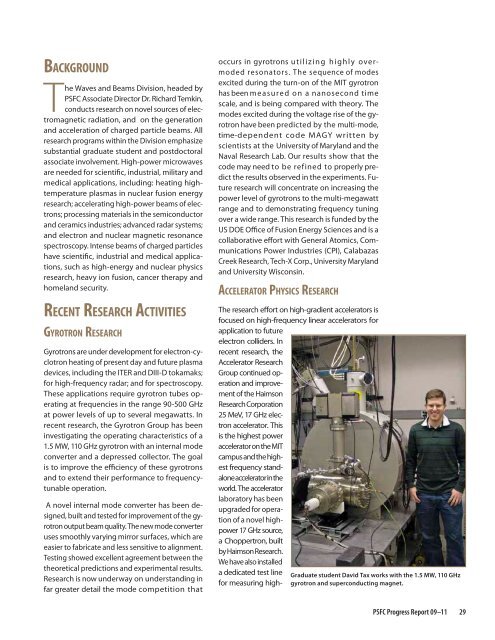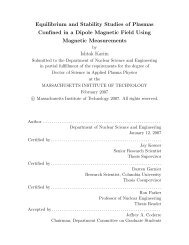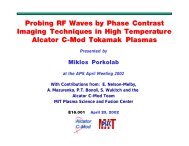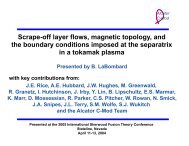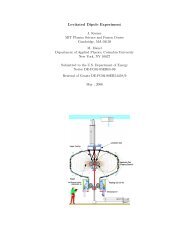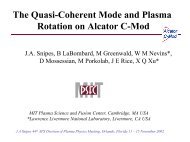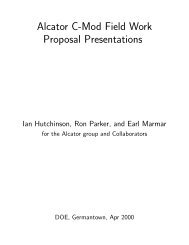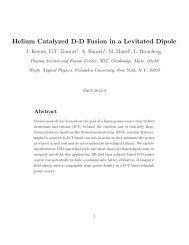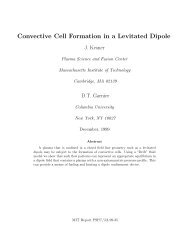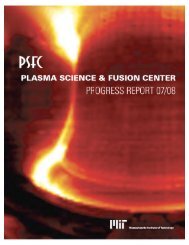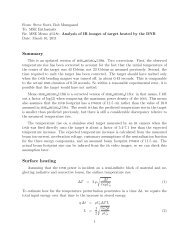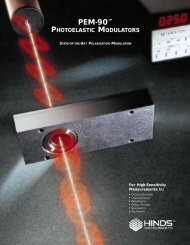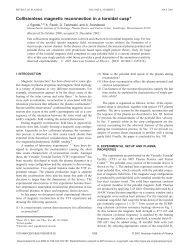Download a copy of the latest PSFC Progress Report - Plasma ...
Download a copy of the latest PSFC Progress Report - Plasma ...
Download a copy of the latest PSFC Progress Report - Plasma ...
You also want an ePaper? Increase the reach of your titles
YUMPU automatically turns print PDFs into web optimized ePapers that Google loves.
Background<br />
The Waves and Beams Division, headed by<br />
<strong>PSFC</strong> Associate Director Dr. Richard Temkin,<br />
conducts research on novel sources <strong>of</strong> electromagnetic<br />
radiation, and on <strong>the</strong> generation<br />
and acceleration <strong>of</strong> charged particle beams. All<br />
research programs within <strong>the</strong> Division emphasize<br />
substantial graduate student and postdoctoral<br />
associate involvement. High-power microwaves<br />
are needed for scientific, industrial, military and<br />
medical applications, including: heating hightemperature<br />
plasmas in nuclear fusion energy<br />
research; accelerating high-power beams <strong>of</strong> electrons;<br />
processing materials in <strong>the</strong> semiconductor<br />
and ceramics industries; advanced radar systems;<br />
and electron and nuclear magnetic resonance<br />
spectros<strong>copy</strong>. Intense beams <strong>of</strong> charged particles<br />
have scientific, industrial and medical applications,<br />
such as high-energy and nuclear physics<br />
research, heavy ion fusion, cancer <strong>the</strong>rapy and<br />
homeland security.<br />
Recent Research Activities<br />
Gyrotron Research<br />
Gyrotrons are under development for electron-cyclotron<br />
heating <strong>of</strong> present day and future plasma<br />
devices, including <strong>the</strong> ITER and DIII-D tokamaks;<br />
for high-frequency radar; and for spectros<strong>copy</strong>.<br />
These applications require gyrotron tubes operating<br />
at frequencies in <strong>the</strong> range 90-500 GHz<br />
at power levels <strong>of</strong> up to several megawatts. In<br />
recent research, <strong>the</strong> Gyrotron Group has been<br />
investigating <strong>the</strong> operating characteristics <strong>of</strong> a<br />
1.5 MW, 110 GHz gyrotron with an internal mode<br />
converter and a depressed collector. The goal<br />
is to improve <strong>the</strong> efficiency <strong>of</strong> <strong>the</strong>se gyrotrons<br />
and to extend <strong>the</strong>ir performance to frequencytunable<br />
operation.<br />
A novel internal mode converter has been designed,<br />
built and tested for improvement <strong>of</strong> <strong>the</strong> gyrotron<br />
output beam quality. The new mode converter<br />
uses smoothly varying mirror surfaces, which are<br />
easier to fabricate and less sensitive to alignment.<br />
Testing showed excellent agreement between <strong>the</strong><br />
<strong>the</strong>oretical predictions and experimental results.<br />
Research is now underway on understanding in<br />
far greater detail <strong>the</strong> mode competition that<br />
occurs in gyrotrons utilizing highly overmoded<br />
resonators. The sequence <strong>of</strong> modes<br />
excited during <strong>the</strong> turn-on <strong>of</strong> <strong>the</strong> MIT gyrotron<br />
has been m e asure d o n a nanosecond time<br />
scale, and is being compared with <strong>the</strong>ory. The<br />
modes excited during <strong>the</strong> voltage rise <strong>of</strong> <strong>the</strong> gyrotron<br />
have been predicted by <strong>the</strong> multi-mode,<br />
time-dependent code MAGY written by<br />
scientists at <strong>the</strong> University <strong>of</strong> Maryland and <strong>the</strong><br />
Naval Research Lab. Our results show that <strong>the</strong><br />
code may need to be refined to properly predict<br />
<strong>the</strong> results observed in <strong>the</strong> experiments. Future<br />
research will concentrate on increasing <strong>the</strong><br />
power level <strong>of</strong> gyrotrons to <strong>the</strong> multi-megawatt<br />
range and to demonstrating frequency tuning<br />
over a wide range. This research is funded by <strong>the</strong><br />
US DOE Office <strong>of</strong> Fusion Energy Sciences and is a<br />
collaborative effort with General Atomics, Communications<br />
Power Industries (CPI), Calabazas<br />
Creek Research, Tech-X Corp., University Maryland<br />
and University Wisconsin.<br />
Accelerator Physics Research<br />
The research effort on high-gradient accelerators is<br />
focused on high-frequency linear accelerators for<br />
application to future<br />
electron colliders. In<br />
recent research, <strong>the</strong><br />
Accelerator Research<br />
Group continued operation<br />
and improvement<br />
<strong>of</strong> <strong>the</strong> Haimson<br />
Research Corporation<br />
25 MeV, 17 GHz electron<br />
accelerator. This<br />
is <strong>the</strong> highest power<br />
accelerator on <strong>the</strong> MIT<br />
campus and <strong>the</strong> highest<br />
frequency standalone<br />
accelerator in <strong>the</strong><br />
world. The accelerator<br />
laboratory has been<br />
upgraded for operation<br />
<strong>of</strong> a novel highpower<br />
17 GHz source,<br />
a Choppertron, built<br />
by Haimson Research.<br />
We have also installed<br />
a dedicated test line<br />
for measuring high-<br />
Graduate student David Tax works with <strong>the</strong> 1.5 MW, 110 GHz<br />
gyrotron and superconducting magnet.<br />
<strong>PSFC</strong> <strong>Progress</strong> <strong>Report</strong> 09–11 29


